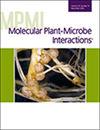Po-Yuan Shih, Stéphanie Le Bras, Rémi Ollivier, Hélène Boulain, Stéphanie Morlière, Yannick Outreman, Jean-Christophe Simon, Akiko Sugio
求助PDF
{"title":"A Salivary Effector of the Pea Aphid Interacts with Pea Proteins and Enhances Its Performance on the Host Plant.","authors":"Po-Yuan Shih, Stéphanie Le Bras, Rémi Ollivier, Hélène Boulain, Stéphanie Morlière, Yannick Outreman, Jean-Christophe Simon, Akiko Sugio","doi":"10.1094/MPMI-08-24-0089-R","DOIUrl":null,"url":null,"abstract":"<p><p>Aphids have intricate interactions with their host plants, but the molecular mechanisms behind these interactions remain largely unknown. The pea aphid, <i>Acyrthosiphon pisum</i>, is a legume specialist that forms a complex of several biotypes, each specialized in feeding on a few legume species. Aphids inject a cocktail of salivary effector proteins into plants to suppress plant immunity and promote their performance, such as fecundity. Previous studies showed that subsets of salivary effector genes of <i>A. pisum</i> are differentially expressed between the pea- and alfalfa-adapted biotypes. We hypothesized that the salivary effector genes that are important for <i>A. pisum</i> to feed on pea (<i>Pisum sativum</i>) are highly expressed in the pea-adapted biotype compared with non-adapted ones and selected such genes for functional characterization. We examined 10 candidate genes and found that expression of the salivary gene <i>LOC100159932</i> (<i>Ap4</i>) in pea leaves increased the fecundity of the <i>A. pisum</i> pea biotype. A yeast two-hybrid screening using Ap4 as a bait identified two pea proteins named PsBPL1 and PsBPL2 that showed high homology with Arabidopsis BPL (Binding Partner of ACD11-Like) proteins, which are conserved in plants and fungi and known to be involved in plant immunity. GFP-tagged Ap4 proteins produced puncta in <i>Nicotiana benthamiana</i> cytoplasm, and a bimolecular fluorescence complementation experiment confirmed the interaction of Ap4 and PsBPL1 and PSBPL2 in planta. These results highlight Ap4's role as an effector and suggest the involvement of BPL proteins in pea-aphid interactions. [Formula: see text] Copyright © 2025 The Author(s). This is an open access article distributed under the CC BY 4.0 International license.</p>","PeriodicalId":19009,"journal":{"name":"Molecular Plant-microbe Interactions","volume":" ","pages":"MPMI08240089R"},"PeriodicalIF":3.4000,"publicationDate":"2025-09-18","publicationTypes":"Journal Article","fieldsOfStudy":null,"isOpenAccess":false,"openAccessPdf":"","citationCount":"0","resultStr":null,"platform":"Semanticscholar","paperid":null,"PeriodicalName":"Molecular Plant-microbe Interactions","FirstCategoryId":"99","ListUrlMain":"https://doi.org/10.1094/MPMI-08-24-0089-R","RegionNum":3,"RegionCategory":"生物学","ArticlePicture":[],"TitleCN":null,"AbstractTextCN":null,"PMCID":null,"EPubDate":"","PubModel":"","JCR":"Q2","JCRName":"BIOCHEMISTRY & MOLECULAR BIOLOGY","Score":null,"Total":0}
引用次数: 0
引用
批量引用
Abstract
Aphids have intricate interactions with their host plants, but the molecular mechanisms behind these interactions remain largely unknown. The pea aphid, Acyrthosiphon pisum , is a legume specialist that forms a complex of several biotypes, each specialized in feeding on a few legume species. Aphids inject a cocktail of salivary effector proteins into plants to suppress plant immunity and promote their performance, such as fecundity. Previous studies showed that subsets of salivary effector genes of A. pisum are differentially expressed between the pea- and alfalfa-adapted biotypes. We hypothesized that the salivary effector genes that are important for A. pisum to feed on pea (Pisum sativum ) are highly expressed in the pea-adapted biotype compared with non-adapted ones and selected such genes for functional characterization. We examined 10 candidate genes and found that expression of the salivary gene LOC100159932 (Ap4 ) in pea leaves increased the fecundity of the A. pisum pea biotype. A yeast two-hybrid screening using Ap4 as a bait identified two pea proteins named PsBPL1 and PsBPL2 that showed high homology with Arabidopsis BPL (Binding Partner of ACD11-Like) proteins, which are conserved in plants and fungi and known to be involved in plant immunity. GFP-tagged Ap4 proteins produced puncta in Nicotiana benthamiana cytoplasm, and a bimolecular fluorescence complementation experiment confirmed the interaction of Ap4 and PsBPL1 and PSBPL2 in planta. These results highlight Ap4's role as an effector and suggest the involvement of BPL proteins in pea-aphid interactions. [Formula: see text] Copyright © 2025 The Author(s). This is an open access article distributed under the CC BY 4.0 International license.
豌豆蚜虫的一种唾液效应物与豌豆蛋白相互作用并提高其在寄主植物上的性能。
蚜虫与寄主植物有复杂的相互作用,但这些相互作用背后的分子机制在很大程度上仍然未知。豌豆蚜虫Acyrthosiphon pisum是一种豆科植物专家,它形成了几种生物型的复合体,每种生物型都专门以几种豆科植物为食。蚜虫将唾液效应蛋白的混合物注入植物体内,抑制植物的免疫,促进植物的繁殖能力等。先前的研究表明,在豌豆和苜蓿适应的生物型中,沙蚤唾液效应基因亚群的表达存在差异。我们假设在豌豆适应型中,与非适应型相比,对豌豆采食重要的唾液效应基因在豌豆适应型中高度表达,并选择这些基因进行功能表征。我们检测了10个候选基因,发现唾液基因LOC100159932 (Ap4)在豌豆叶片中的表达提高了A. pisum豌豆生物型的生殖力。以Ap4为诱饵进行酵母双杂交筛选,鉴定出两个与拟南芥BPL (Binding Partner of ACD11-Like)蛋白高度同源的豌豆蛋白PsBPL1和PsBPL2,这两个蛋白在植物和真菌中保守,已知与植物免疫有关。gfp标记的Ap4蛋白在烟叶细胞质中产生斑点,并通过双分子荧光互补实验证实了Ap4在植物中与PsBPL1和PSBPL2相互作用。这些结果突出了Ap4作为效应物的作用,并表明BPL蛋白参与了豌豆蚜虫的相互作用。
本文章由计算机程序翻译,如有差异,请以英文原文为准。

 求助内容:
求助内容: 应助结果提醒方式:
应助结果提醒方式:


